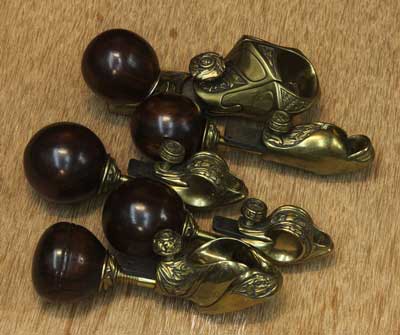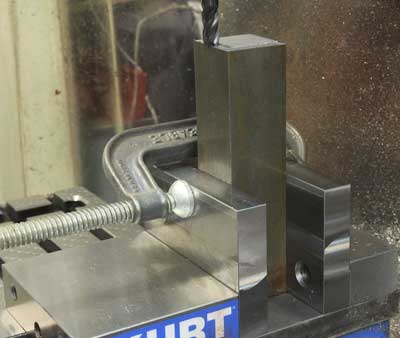
Reviewing
"Small Shop"
Tools
© Frank Ford, 2010; Photos by FF
Here are some tools I've acquired over the
last few years. They're items made by smaller shops - generally not the kind of
thing found in the catalogs of big tool suppliers. Partly because I make and
sell a few highly specialized tools in small quantities, I like to support the
individual and small groups who make such things.
I'll present them in in no particular order,
starting with the ones that almost got away - a series of luthier hand planes
made by Christopher Laarman:
I first saw these planes at the Healdsburg
Guitar Festival a dozen or so years ago. Christopher was selling them in the
guitar display room, and I bought one. They were kinda pricey, so I thought I'd
get some later on, you know. My pal, Jay Hostettler of Stewart MacDonald's
Guitar Shop Supply, bought a full set. I was a bit envious but I figured there
always was next year.
Well, next year didn't come - the Festival
became a biennial event. When the next Festival was held, Christopher wasn't
there, so I called him at his studio in Oregon and asked if I could get the
other planes I had put off buying. He told me he'd sold the last of them and
had quit making them altogether because he was disappointed to hear that most
of them went into "collections on mantle pieces" rather than being
used as tools. We talked for a while, and after I told him I really liked the
way they worked he said he'd polish up the last of a few castings he hadn't
finished and get me the planes I wanted. This is me using the plane leveling
a spruce patch, working inside a vintage 1867 Martin guitar:
Every time I encounter a really cool tool
like these planes, I immediately ask myself how I'd feel if I hesitated and missed
out. So my current default is set on "buy." And that was my first
impulse when I saw this cool micrometer, all done up in vintage styling:
Cool it is, and it was made using antique
and vintage machine tooling, by Jeff Marcus in Great Neck, NY. His shop, Cool
Weld Studios, is represented on the Web: www.coolweldstudios.com.
Often enough I've encountered guys who just
don't "get" this one. The Cool Weld mic is not competing with
Starrett for price and utility. It's a showpiece. When I measure the gauge of
a guitar string for a customer in the shop, I often get the same kind of reaction
and approval I did when I drove my vintage Metropolitan around town.
And, best of all, it's the ultimate gift for
a machinist friend. Trust me - there are times when a guy needs a prezzie.
Next up is the useful little
finger-sensitive "Hummingbird" drilling table from Jose Rivera, for
delicate holes in tiny parts:
Jose makes them in his home shop in Vallejo,
CA, and distributes them through Little
Machine Shop, a supplier of just
that, small machine tool stuff:
In the photo, I'm drilling a piece of ivory,
which has a nasty tendency to gum up on small drills. With the Hummingbird, I
can bounce up and down quickly and easily for hundreds of pecking cycles to
clear the chips. Jose has posted a short video on YouTube.
Another fine item from Little
Machine Shop is this radius turning tool. It's a kind of "off
hours" thing made by OMW, a small CNC machine shop in Novato, CA:
It's nicely turned out, solid and stable for a lightweight tool. I've used
this one for a number of years now, and it performs very well. Because it's a
lightweight, I do have to be VERY slow and careful when turning steel.
This lathe accessory comes with a fine set of instructions, which, of course, I lost shortly after acquiring it. I developed my own system for its use, and if you're interested, I wrote up a description of the process: My Ball Turning Technique.
I don't know anything about the maker of
Monster Jaws, but I have bought several sets from eBay, and I've been pleased
by how inexpensive and well made they are.
Soft aluminum jaws for specialized holding
jobs:
An eight-inch set of soft steel ones to
extend the length:
And a super tall set to hold vertical items:

I like to give the tall ones a bit of help squeezing.
In addition to the eBay presence, there is a
Web site: http://monster-jaws.com
There are lots of ways to do hand tapping on
the mill, but this device is the first thing I reach for every time:
It's a self-centering tap wrench made by
Northern Machining in Norfolk, NY, and it is so quick and easy to use.
The idea is to grip the 5/16" spigot
with a collet or chuck, and tap away in perfect alignment, lowering the mill
or drill press quill in increments as you go (unless you have three arms, of
course) and it works quite well that way:
Here's how I cheat a bit when I use the tap
handle. I use a 5/16" collet which I do not tighten with the draw bar -
it's completely loose. I lower the quill all the way down until the collet is
shoved way up inside:
Then I simply let the collet drop as I tap
the hole - no quill adjustment needed at all:
From Valencia, CA, it's the Venture Quest
Pro Stop:
I found this one on eBay, and that's the
only contact I have for them. Their eBay seller name is "venqust1."
Quick to set up and solid - I use it for
"outboard" part location almost exclusively.
Here's the "Follower Rest," made
in a small shop in Louisiana, and once available from a Web site by the same
name. Unfortunately, it appears that the site is not active, and I suppose that
means the tool is no longer available. When it was first announced, the only
models had dovetails cut for BXA and larger size tool posts. . It looked like
such a good idea to me that I made a miniature size one after
seeing photos of the big ones. As soon as it was available in my size I ordered
one, and I believe I may the first one made for AXA, because there's what looks
to be a serial number of "01" stamped on the end.
So I show it here so it can serve as a
reminder to act on your good impulses, and to serve as a reminder that you
could make up something for yourself if you want to.
As you can see, it's a pretty hefty tool for
the AXA size tool post, but often enough a bit of extra mass can be a good
thing for stability:
To set up, I center drill and use a standard
turning tool to make an initial cut to the diameter I want on the end of my long
piece of stock, and then adjust the brass follower up nice and tight against
the cut surface. Then I extend the stock, bring up the tailstock center, and
proceed to cut toward the headstock, nice as you please:
It sets up so quickly and easily that I
haven't gotten out my lathe's "real" follow rest since I acquired the
Follower Rest.
Jeez, here comes another one that's out of
production. It's a standard tool, and perfectly good ones like it are available
from lots of manufacturers. This one is the Hermann Schmidt edge finder, and it
became unavailable this year. Seems it was made by an individual who quit
supplying them.
Too bad - it was clearly the only thing in
the Hermann Schmidt catalog I could afford! It's not a big deal, but it was the
first edge finder I acquired that really jumped for me. Maybe my Starrett was
sub-par, but once I got the Schmidt, I gave the Starrett away and got a second
Schmidt, just in case. Seems I drop more things every year, so for a few bucks
(fifty, to be more accurate) I felt I caught a bit of insurance.
The minute I had it in hand I noticed the
finely lapped sliding surfaces and smooth action.
Made by Alphonse Diciolla in Cleveland, OH, here's the VISE ANVIL -
This one is about as simple as it could be. A big nasty slice of round steel with recesses milled for holding in a vise, it's a small anvil substitute, or "bench block," and it's pretty cool:
Made of 4340 steel, through-hardened to 38-40 RC, it resists any marking or denting from my hammer. It's 4-5/8" diameter, 1-3/4" thick, so it has enough mass to give a good bounce as I hit the work piece. I reckon that if I ever do manage to scar the face up, I can grind it and have a fresh smooth surface with very little effort, and no loss of hardness.
I have a "real" anvil, but I really do so little forging or other hammering, that I usually end up smacking things on the anvil section of my bench vise, rather than dragging out the anvil from its hiding place behind the junk in the corner. This bench block really fills a need in my shop. Sure, I could have made one easily enough, but heat treating a hunk that big would be way beyond my capability or simply too expensive. At about fifty bucks including shipping, it's less than half the minimum charge at my local steel treatment plant.
As of 4/17/2011, you can get one of these from the maker on eBay or at his Etsy store - he goes by the name AWDJR: http://www.etsy.com/shop/AWDJR?ref=seller_info He also sells on eBay, and has a YouTube video.